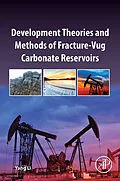Development Theories and Methods of Fracture-Vug Carbonate Reservoirs explores the theories and methods for successful development of a fracture-vug reservoir by presenting the developmental strategies used in the Tahe oilfield. Some of the theories and methods of developing the Tahe fracture-vug reservoirs have been inspired by two China national research projects: The 'Basic research on development of fracture-vug carbonate reservoirs' (2006-2010), and the 'Basic research on production mechanism and oil recovery enhancement of fracture-vugcarbonate reservoirs' (2011-2015), with support by the National Basic Research Program of China. These theories and methods have facilitated the successful development of the fracture-vug reservoir in the Tahe oilfield, providing effective technologies and inspirations to developing similar reservoirs everywhere. - Provides information on both theoretical developments and technological innovations - Applies the modern karst formation characterization and the fracture-vug hierarchical structure to geological investigations of fracture-vug carbonate reservoirs - Introduces the karst facies-controlling 3D geologic modeling of fracture-vug reservoir formations - Proposes the coupled-processing and equivalent multi-medium numerical simulation methods of fracture-vug reservoirs - Presents development methodologies and techniques of water/gas flooding
Autorentext
Yang Li is the vice chief engineer of Sinopec Corp., an Academician of the Chinese Academy of Engineering, and is engaged in research of petroleum geology and oil/gas reservoir development. Yang Li served as the chief scientist for two projects 'Basic research on development of fracture-vug carbonate reservoirs'(2006-2010), and 'Basic research on production mechanism and oil recovery enhancement of fracture-vug carbonate reservoirs' (2011-2015) supported by the National Basic Research Program of China (973 Program).
Klappentext
Development Theories and Methods of Fracture-Vug Carbonate Reservoirs explores the theories and methods for successful development of a fracture-vug reservoir by presenting the developmental strategies used in the Tahe oilfield.
Some of the theories and methods of developing the Tahe fracture-vug reservoirs have been inspired by two China national research projects: The 'Basic research on development of fracture-vug carbonate reservoirs' (2006-2010), and the 'Basic research on production mechanism and oil recovery enhancement of fracture-vugcarbonate reservoirs' (2011-2015), with support by the National Basic Research Program of China.
These theories and methods have facilitated the successful development of the fracture-vug reservoir in the Tahe oilfield, providing effective technologies and inspirations to developing similar reservoirs everywhere.
- Provides information on both theoretical developments and technological innovations
- Applies the modern karst formation characterization and the fracture-vug hierarchical structure to geological investigations of fracture-vug carbonate reservoirs
- Introduces the karst facies-controlling 3D geologic modeling of fracture-vug reservoir formations
- Proposes the coupled-processing and equivalent multi-medium numerical simulation methods of fracture-vug reservoirs
- Presents development methodologies and techniques of water/gas flooding
Inhalt
1. Fracture-vug carbonate reservoirs: origins and features
2. Geophysical description of fracture-vug carbonate reservoirs
3. Three-dimensional geology modelling of fracture-vug carbonate reservoirs
4. Fluid flow pattern of fracture-vug carbonate reservoirs
5. Numerical modelling of fracture-vug carbonate reservoirs
6. Development technology for fracture-vug carbonate reservoir
